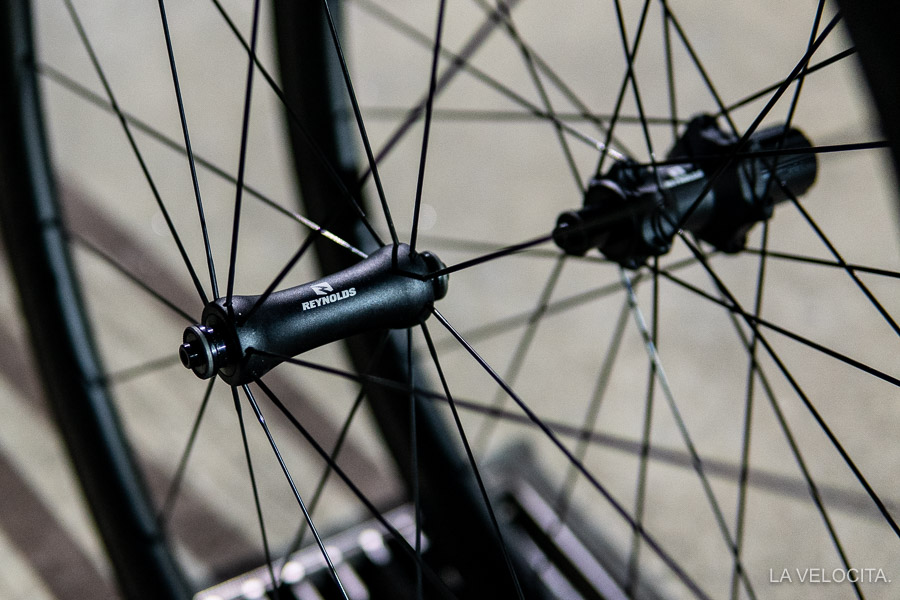Reynolds AR 41 X wheelset review

Reynolds have made a very nice wheel with quite a big problem
Words and Images - James Raison
Don’t let the disc brake zealots tell you that rim brakes are dead! Far from it. There’s still high quality rim brake wheels streaming out of factories and shops the world over. I’ve been testing some. Specifically the Reynolds AR 41 X; a wheel with a spec sheet straight from my wishlist of features and a price of $2,399 AUD.
I tested two sets for reasons that I’ll explain below. One on a TIME Alpe d’Huez then another in my own Specialized Allez. So, what are they like?
ABOUT
The AR 41 X are a very contemporary wheelset:
Rim Width: Internal 19mm, External 27mm
Rim Depth: 41mm
Hub: Reynolds - 10 degree engagement
Spoke Count: 20 Front, 24 Rear
Brake Interface: Ctg2 heat resistant rim brake track
Freehub options: Shimano/SRAM 9-11spd, Campy or SRAM XD-R
Wheelset Weight: measured at 825g rear and 650g front with rim tape, 5g under the claimed 1480g by Reynolds.
In the box:
Wheels
Skewers
Tubeless valves
Reynolds blue brake pads
Owner manuals
The rims of the AR 41 X are loaded with everything I’d want from a rim brake clincher. They’ve got a fat external width of 27 mm (19 mm internal) measured slightly below the brake track. They expanded 25 mm Schwalbe Pro Ones and Vittoria Corsa Graphenes tyres to a porky 26.5 mm. Reynolds have made them tubeless ready too, giving you the option of sweet puncture free, low tyre pressure riding. I didn’t set them tubeless but absolutely would if I owned them.
Reynolds claim some aero optimisations to make them quick and stable in the wind, more on this below, and some excellent work has been done with the “Ctg2 brake track” that is a claimed 30% more resistant to heat than the previous generation. The net effect is going faster and stopping faster.
Reynolds has radially laced 20 Sapim Cx-sprint bladed spokes on the front and cross-laced 24 at the back. All the spokes are attached with external alloy nipples for easy servicing. The hubs are Reynolds own branded and they don’t disclose much about them apart from a 10° freehub engagement. No mention of bearing size or construction.
All the spec looks good, but how does it ride?
THE RIDE
There’s a lot to like about riding the AR 41 X.
To me, 40 mm (the AR 41 X is technically 41 mm) rims are the perfect all-round height for mixed parcours riding; deep enough to capitalise on aerodynamics but not so deep to make the bike a handful in the wind. They’re light enough to be very capable climbers, but still deep enough to slice the air and maintain speed. I spend all of my time riding in the Adelaide Hills with every terrain on offer short of alpine climbs.
The AR 41 X climbed outstandingly well with low weight giving good acceleration and their aero-optimised rim and spokes keep them spinning. On flatter roads they roll easily too, with smooth bearings helping things along. There was no mind-blowing moment of blistering speed or revelatory experience, rather, they always felt good. Even gross, blustery wind couldn’t unsettle them.
The Reynolds AR 41 X are a very nice all-rounder to ride
There’s plenty of comfort on offer too with their substantial width letting me comfortably run the tyres at 70 psi. Adding the wheels to the smooth and stiff TIME Alpe d’Huez 01 frame created a brilliant tandem of sustainable raciness. They noticeably sped up my Specialized Allez too with the wheels rolling much more rapidly than the Craftworx Ultimas that live on that bike. Descending is a pleasure too, with the rim ignoring the wind and the tyres spread wide at low pressure riding the bumps capably.
I did notice a differences between the freehub engagement of the two sets. The engagement on the Shimano set felt quicker, and properly like the claimed 10˚ engagement. On the other set I clanged into the pawls quite a lot. I’ll chalk that difference up to age.
BRAKING
The Reynolds AR 41 X decelerate well for carbon clinchers, among the best I’ve used. I found plenty of power once I’d grabbed a handful of lever. They’re still not a match for the consistency and power of good aluminium rims, but I doubt carbon ever will be considering the advent of disc brakes.
My favourite training hill, Mt Osmond, happens to be the perfect place to test carbon clinchers because it has two very hard stops from high speed right after each other. The Reynolds were impressive on that descent, with only a small hint of brake power lag into the second corner when I was hammering. That doesn’t surprise me because every other carbon clincher I’ve tested on that segment has faded, most of them fading more than the Reynolds.
In normal use I didn’t note any fade or braking issues. There’s a reason why I test on Mt Osmond; it’s the only place with so many hard stops in sequence. On hot days they occasionally squealed but resolutely maintained their power. The powerful Campagnolo Record 12 brakes and Reynolds blue brake pads bring you to a halt reliably and without fuss. The Shimano Ultegra R8000 brakes are even better.
In the wet they show the inherent weakness of soggy carbon rims. You need a couple of seconds to clear the water before you get any stopping power. I can’t complain too much about poor wet braking because that’s how wet carbon braking is.
Nice work Reynolds, the AR 41 X almost stops well enough for me to forget they’re carbon clinchers.
THE RUB
The AR 41 X wheels have a problem though: spoke flex leading to brake rub when out of the saddle. I got sent a second set after I reported how much movement there was in the first. Alas, the second set had the same issue. While the output is brake rub, it’s not likely to be a “stiffness” problem necessarily.
While riding, I noticed consistent brake rub when riding out of the saddle, every time I got out of the saddle. Off the bike I was easily able to pinch the rim between thumb and index finger, then wiggle it side-to-side freely and touch the rim to the pads. I had the spoke tension checked by a mechanic and they were all within expected tolerances, with a hint unevenness. Unfortunately the rub remained after the tensions were tweaked.
The second set on my Allez moved in the same way. There was less brake rub on that bike because of the rigid aluminium rear triangle and the brakes being mounted to a dropped seat stay - more on this below. Still it flexed every time I was out of the saddle. I took the wheels in to a local wheel builder with decades of experience to have a look. His prognosis was; a bit of everything. The hug flange width is narrow, the flange diameter is small, and the Sapim CX-Sprint spokes must have low tension to protect the carbon rim.
The narrow flange width and low spoke tension lead to a lot of brake rub on the rear
This ties into a broader issue with perceived carbon wheel "stiffness" or "flex". Rigid carbon rims are very resistant to flex and want to maintain their roundness at all times, whereas aluminium rims will tend to flex more readily under load. Stiff carbon rims force the spokes to bear the brunt of the rider’s power. The end result is brake pad rub. Standard rim brakes mounted onto the seatstay junction are close to opposite the load point where the tyre touches the road, hence the movement is most noticeable as brake rub. This explains why there were no issues with spoke tension detected by the first mechanic, and why the wheel builder identified flange dimensions and low spoke tension as potential issues leading to the brake rub.
Editorial note: Bikesportz sent a link to an explanatory Slowtwitch article; Debunking Wheel Stiffness as an explainer about why the Reynolds AR 41 Xs have brake rub. My initial feedback to them was that the wheels lacked stiffness, which was not a correct explanation of what was happening. I recommend all you bike nerds have a read of that article and keep the information in mind when assessing carbon wheels.
WRAPPING UP
I like a lot about the Reynolds AR 41 X. The rim profile is excellent; wide, aero, and tubeless. Braking is darn good for carbon clinchers too. Riding them is a pleasure on almost all terrain and $2,399 is solid value too.
The relentless brake rub is very disappointing though, especially considering how good other aspects of the wheel are. I feel like an exasperated parent with these wheels. They have so much potential.
Disclosure statement: This wheelset was sent for review by Bikesportz. It’s not a paid review and the wheels were returned.











